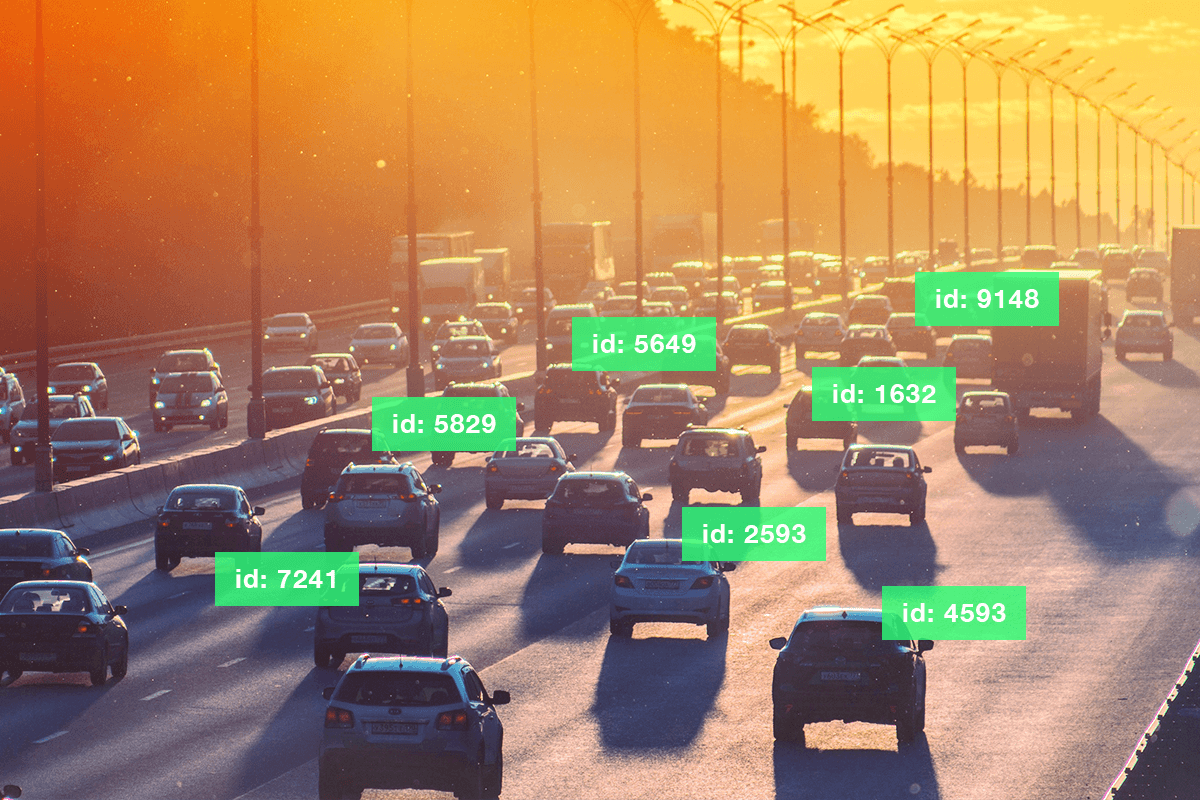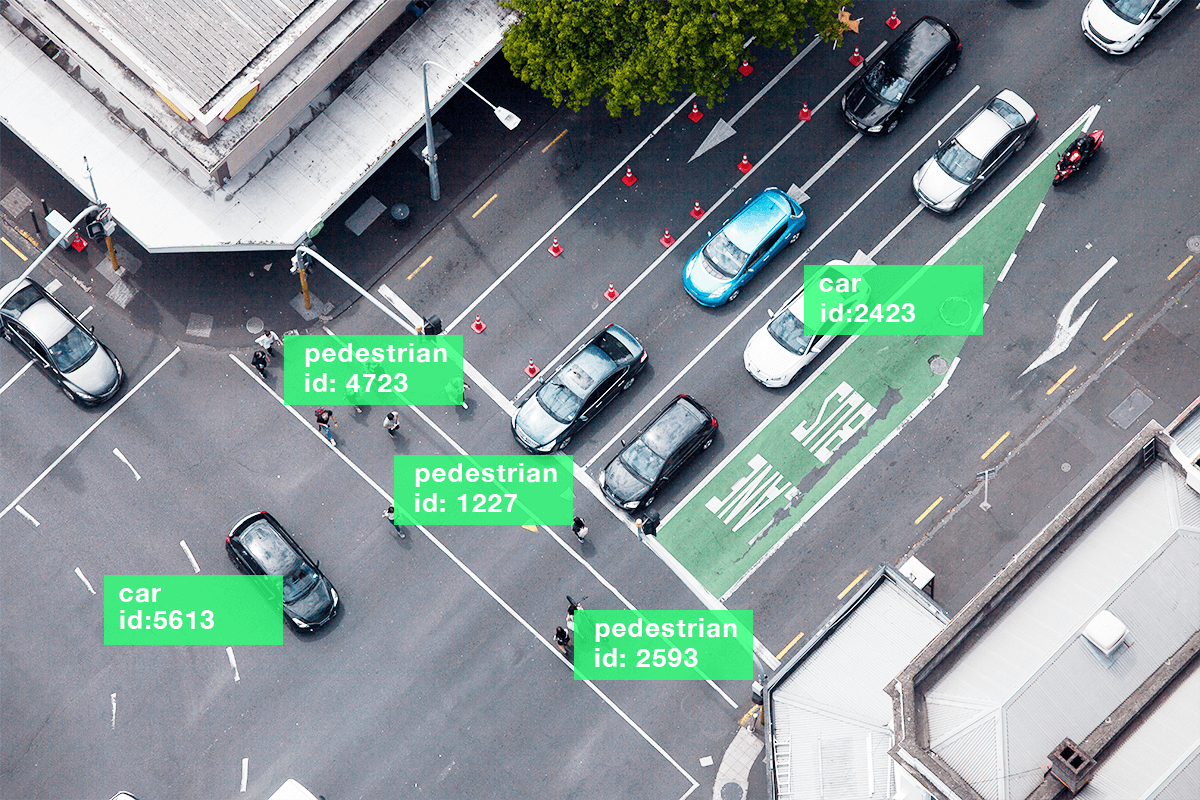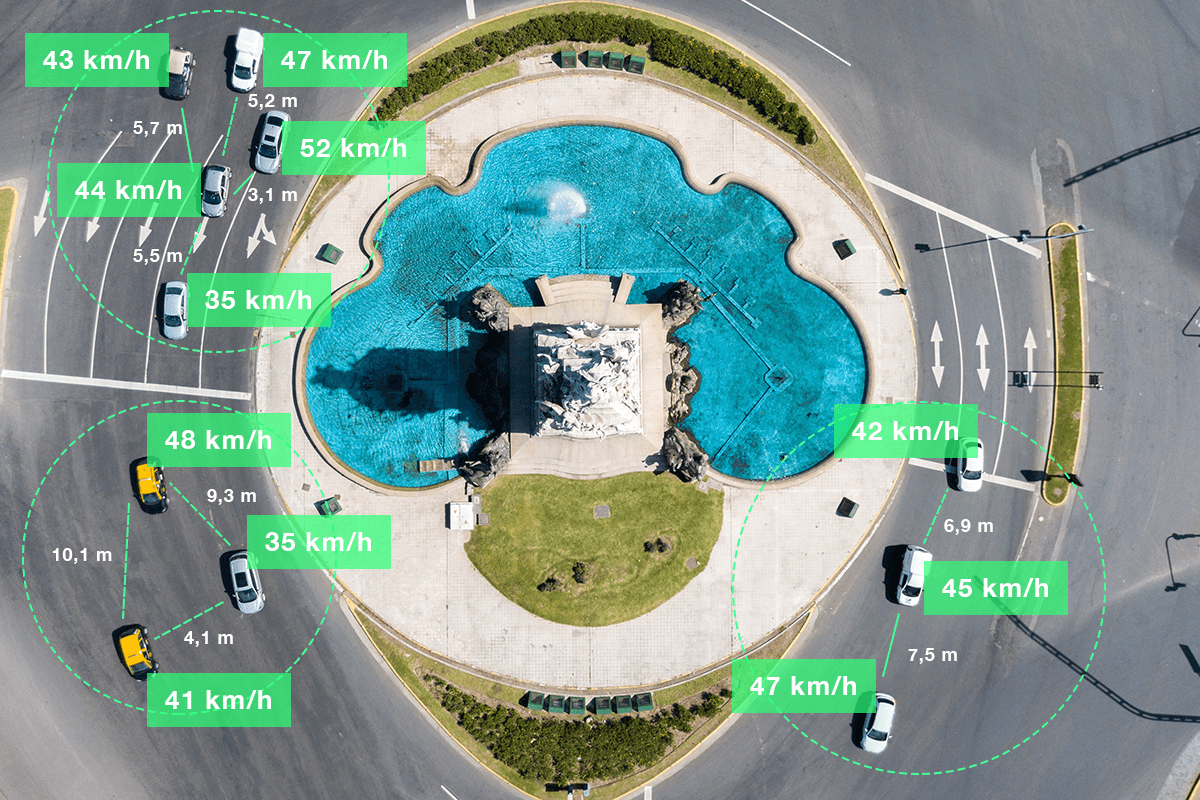Let’s Discuss Your Smart Traffic Solution
Probably some people were wondering what are these small cameras on traffic lights. These are the traffic cameras, and they serve as one small example of urban infrastructure nowadays that can be improved by Softengi in creating video analytics software.
Generally, Video Analytics software development based on Computer Vision and Machine Learning are becoming integrated part of smart cities and futuristic urban spaces. First of all, because these solutions significantly facilitate traffic and logistics depending on where installed. A number of reports signify that the state, local authorities, and businesses show growing interest in Video Analytics solutions. According to MarketsandMarkets Global Forecast, Video Analytics Market will grow 19% from US$ 4.9 billion in 2020 to US$ 11.7 billion in 2015 for Traffic Monitoring, Incident Detection, People/Crowd Counting, Intrusion Management On-premises and Cloud.
For an AI software developer company, Video Analytics for smart traffic comes to automatically recognizing temporal, spatial, or disguised events on the roads in videos using Computer Vision and Machine Learning. The video-analytical solutions can detect different events: traffic jams, accidents, speeding, suspicious objects, and flashes of fire. Artificial Intelligence performs these tasks more effectively than humans or other technologies do.
How AI (ML+CV) Improves Traffic And Logistics
In this article, you will find out about the following:
- Number Plate Detection
- Traffic Analytics for Traffic Control
- Video Panorama Stitching
- Asset Tracking: People/Vehicle Tracking
- Speed and Motion Analysis
- Intrusion and Zone Detection
- IS and GPS Mapping, and more
- CV for Parking Solutions
Number Plate Detection
The state, local authorities, and businesses employ image-processing technologies such as Automatic Number-Plate Recognition (ANPR) to identify vehicles by their number/license plates. ANPR-based security and traffic applications effectively handle their tasks, and that is why they are becoming more in demand for:
- Speed detection;
- Surveillance;
- Access control;
- Easy parking.

Applications of Automatic Number-Plate Tracking
Application | Place |
Speed detection | To classified facilities, business centers, residential areas |
Surveillance | On the highways |
Access control | To classified facilities, business centres, residential areas |
Parking assistance | For easy or contact-free entrance and departure on parking spots |
To do automatic number-plate detection, developer companies now employ Machine Learning with Neural Networks and open-source ML libraries such as Keras, Pytorch, and MXNet. These are advanced tools to enhance the standard developer kits for such tasks.
3 Phases of Automatic Number-Plate detection
Automatic number-plate detection in any solution runs through these three phases:
- Detect the number plate on a vehicle;
- Perform segmentation of characters on the number plate;
- Recognize characters on the number plate.
Afterward, in the above-mentioned situations of speeding on highways and parking, ML immediately detects a certain number plate in any environment, including heavy traffic, or sharpens the blur numbers. Then it alerts the recognized suspected number plate to the system manager. It also performs other actions as opening the gate for parking for recognized registered residents. To learn the sample coding process of an automatic number-plate reading with Python and Machine Learning, please see the open blog on Medium.
If you need a solution with Automatic Number-Plate Recognition, Softengi offers systems that can:
- Support the current number plates worldwide;
- Integrate with the current software systems that you are using;
- Have affordable price.
Traffic Analytics For Traffic Control
Identifying parts of the roads and intersections with the worst incident records, injuries, and fatalities is the main reason to employ intelligent traffic analytics widely. Traffic analytics solutions with Computer vision and Machine Learning are the best solutions for traffic control and can detect the following:
- Traffic congestions and large amounts of traffic;
- Pedestrian density on crossings and unexpected pedestrians crossing the road;
- Stickiness, including usual pedestrian and bicycle routes.
The traffic analytics solutions can transmit this data to devices of executive officers and representatives of local authorities for informed decision-making for traffic control.
For example, possible decisions based on video analytics solutions can be to send out a police person for a traffic accident report on a highway or create another pedestrian crossing.
Softengi’s Approach to Video Analytics in Traffic Control
Softengi | Video Analytics Solution | Executive Officer |
Develops Video Analytics Solution with cameras for temporary installation on suspected locations, roads, or intersections. | Collects videos of suspected locations.Processes videos into traffic data. Automatically transmits traffic data from videos to devices. | Receives traffic data from cameras on Mobiles/tablets with Video Analytics App, Desktops with Video Analytics Software |
Benefits of Video Analytics Solutions for Traffic Management
Leveraging these technologies for smart cities can:
- Speed up feedback on traffic accidents on the roads;
- Assist in city planning;
- Benefit local economies;
- Make communities more sustainable.
Features of Video Analytics Solutions for Traffic Control
Video Analytics software development providers can offer real-time alerts of accidents in progress. The solutions can detect abandoned objects on the roads, missing objects, motion of people and vehicles. Video Analytics solutions with Machine Learning have a full tray of features:
- Integrated videos;
- Analysis of real-time videos;
- Indexing of videos;
- Data access control.
Video Panorama Stitching
To widen the scene on the videos from public places, security cameras, or sports channels, broadcast developers apply video stitching. They overlap several videos (images) and stitch them together to form a wider picture or field of view FOV. They can make very informative panorama pictures of high quality.
Main Phases of the Video Stitching Algorithm:
- Define overlapping images to make frames;
- Form one stitching template;
- Edit and align other frames in the template;
- Stitch frames in the template for a wider and smoother resulting view.
Machine Learning coupes with this task much faster than other technologies and with the highest precision. The resulting panoramic image looks like a single piece with flawless, smooth transitions among constituting parts.
Challenges in Panoramic Video Creation and Machine Learning
The possible challenges of panoramic video creation are blurring, shaking, and ghosting. The cameras can differ in class, move rapidly, and record during unfriendly weather conditions such as rain, snow, and dust winds. During nighttime, the resulting video record will depict the image with multiple challenges for video stitching and panoramic view creation. To solve these challenges, developers only stitch images without blurring and stabilize the uneven video. Machine Learning is applied for major challenges such as wide parallax and low texture to recreate missing parts of the resulting panoramic video.
Use Case: Panoramic Video Solution for Safe Driving
As officers of transportation departments develop safe driving standards, all-around vehicle videos can assist in recreating potentially hazardous situations on the roads. To generate such a panoramic type of video, they need to locate several cameras around the vehicle to avoid blind spots and apply panoramic video stitching algorithms that were given coverage earlier in this article. The larger the vehicle is, the more objects surround or affect it and the more cameras they need to install. Also, officers must test a checklist of potentially dangerous traffic situations for this type of vehicle, requiring several panoramic videos.

Stitching videos of multiple cameras is a more difficult task and would normally qualify as a request for Machine Learning algorithms. To create a high-quality panoramic video, ML-based solutions make numerous cuttings of extra parts of the videos and perform numerous seamless and accurate stitching of the remaining frames. The resulting panoramic videos can give a full and in-depth understanding of the safety situation with the vehicle, driver, and all passengers. In this way, safety driving standards can be approved and introduced.
Asset Tracking: People And Vehicle Tracking
To perform surveillance of individual vehicles and make public transportation safer, the state, local authorities, and businesses can apply intelligent solutions for individual vehicle tracking. Using Computer Vision and Machine Learning algorithms, Outsource Video Analytics Software Development providers can track vehicles in real-time using continuous video streams from cameras. These solutions perform vehicle tracking via object detection paradigm to get real-time tracking while deep tracking algorithms fight occlusion.
There are several ways to perform vehicle tracking depending on customer demand and challenges. For example, ResearchGate suggests an extended version that uses a CCTV camera, YOLOv3 object detection, multiple object tracking, Deep SORT, and vehicle re-identification.
Video Analytics solutions with Deep Learning for Vehicle and People tracking provide a good return on investment for Fleet Surveillance and Asset Tracking. Deep Learning in Video Analytics uses layered filters that enhance the detection of objects, people, and violations.
3 Ways How Video Analytics and Deep Learning Protect Your Assets
- Detect restricted objects, suspect-individuals in the restricted perimeter.
Layers of filters of Deep Learning raise the accuracy of detection so high that false alarms caused by shadows and external lights are significantly reduced.
- Detect the restricted behavior.
The solutions can recognize restricted actions that a detected individual performs. For example, someone is loitering around the truck. Layered filters of Deep Learning enhance the detection of restricted actions dramatically.
- Track the individual/object post violation.
Speed and Motion Analysis
Video analytics of speed and motion on the roads is a milestone component of smart cities and intelligent intercity traffic monitoring. This type of analytics contributes to the detection of speeding, deciphering of possible traffic accident scenarios, and prevention of traffic jams. Algorithms for 3D analysis of locations allow new video content analysis for smart traffic and logistics.

Softengi offers Intelligent Speed and Motion Video Analytics software development for smart cities and intelligent intercity traffic monitoring that can:
- Detect vehicles and pedestrians on the roads and highways;
- Classify types of vehicles (cars, trucks);
- Track each vehicle;
- Detect the speed of each vehicle – to identify speeding;
- Analyze the motion of vehicles on the road – to identify possible scenarios of traffic accidents;
- Count vehicles in the detected zone – to identify traffic congestion.
Building solutions with Softengi, the video analytics software development company builds integrated systems for smart traffic monitoring.
Intrusion and Zone Detection
Intelligent Video Analytics for intrusion and zone detection is widely used in smart cities for security reasons as comprehensive surveillance solutions. These solutions monitor public or business zones, metros, buildings, and highways. They automatically monitor the motion of certain objects, people, or vehicles in the detected zones. Once an intrusion is detected, the system alarms and redlines the intruding object.
Solutions trained via Machine Learning accurately differentiate non-dangerous motions and objects from potentially dangerous ones and have very few false alarms. They use channels for monitoring, recording, and analysis and can be architectured securely for any current system that local or state authorities or logistic companies use.
IS and GPS Mapping, and More
Intelligent video analytic software development providers employ Global Positioning Systems GPS and Geographic Information Systems GIS to port geographic information to their solutions. While GPS promptly finds objects and GIS easily maps them, developer companies use them to track objects as a fleet, find objects as lost consignments, and detect perimeters as in intelligent surveillance of warehouses or public spaces. Softengi uses these and similar systems such as GLONASS to enable smooth and accurate operation of Intelligent video analytics software and video analytics app.
CV For Parking Solutions
Intelligent Computer Vision solutions for parking can bring the parking experience for drivers and parking personnel to another level. In addition, they raise drivers’ satisfaction, speed up servicing of vehicles, and cut collisions while parking, driving in, and driving out.
Intelligent Computer Vision solutions for smart parking:
- Recognize license-plate of registered drivers;
- Automatically allow recognized drivers in and out of parking;
- Detect dimensions of parking ways and parking spaces and alert drivers about dangerous parking;
- Detect motion and alert drivers while driving in and out of parking;
- Count and display occupied and free parking spots.
Intelligent parking represents an integrated part of smart cities and completes the futuristic urban picture.
Conclusion
Softengi offers different approaches to effective Video Analytics software development. Computer Vision and Machine Learning contribute much to the rise of smart cities and make traffic monitoring and logistics better. Particularly, Number-Plate Detection prevents speeding on highways. Smart cameras on roads with bad accident history contribute to informed and in-time city planning. Video Panorama Stitching makes 360-degree videos of vehicles for safe driving standards. Asset Tracking solutions enable surveillance of individual vehicles and identification of suspicious individuals in restricted zones. Speed and Motion Analysis is helpful for the security and surveillance of public spaces and warehouses. Intrusion and Zone Detection are widely applied for smart city security. And Computer Vision for parking solutions significantly raises the parking experience for drivers and represents a constituent part of futuristic urban spaces.





